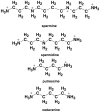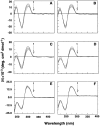Binding of the biogenic polyamines to deoxyribonucleic acids of varying base composition: base specificity and the associated energetics of the interaction
- PMID: 23894663
- PMCID: PMC3722294
- DOI: 10.1371/journal.pone.0070510
Binding of the biogenic polyamines to deoxyribonucleic acids of varying base composition: base specificity and the associated energetics of the interaction
Abstract
Background: The thermodynamics of the base pair specificity of the binding of the polyamines spermine, spermidine, putrescine, and cadaverine with three genomic DNAs Clostridium perfringens, 27% GC, Escherichia coli, 50% GC and Micrococcus lysodeikticus, 72% GC have been studied using titration calorimetry and the data supplemented with melting studies, ethidium displacement and circular dichroism spectroscopy results.
Methodology/principal findings: Isothermal titration calorimetry, differential scanning calorimetry, optical melting studies, ethidium displacement, circular dichroism spectroscopy are the various techniques employed to characterize the interaction of four polyamines, spermine, spermidine, putersine and cadaverine with the DNAs. Polyamines bound stronger with AT rich DNA compared to the GC rich DNA and the binding varied depending on the charge on the polyamine as spermine>spermidine >putrescine>cadaverine. Thermodynamics of the interaction revealed that the binding was entropy driven with small enthalpy contribution. The binding was influenced by salt concentration suggesting the contribution from electrostatic forces to the Gibbs energy of binding to be the dominant contributor. Each system studied exhibited enthalpy-entropy compensation. The negative heat capacity changes suggested a role for hydrophobic interactions which may arise due to the non polar interactions between DNA and polyamines.
Conclusion/significance: From a thermodynamic analysis, the AT base specificity of polyamines to DNAs has been elucidated for the first time and supplemented by structural studies.
Conflict of interest statement
Figures








Similar articles
-
Binding sites of the polyamines putrescine, cadaverine, spermidine and spermine on A- and B-DNA located by simulated annealing.J Biomol Struct Dyn. 2000 Dec;18(3):393-412. doi: 10.1080/07391102.2000.10506676. J Biomol Struct Dyn. 2000. PMID: 11149516
-
Targeting double-stranded RNA with spermine, 1-naphthylacetyl spermine and spermidine: a comparative biophysical investigation.J Phys Chem B. 2014 Sep 25;118(38):11050-64. doi: 10.1021/jp5035294. Epub 2014 Sep 15. J Phys Chem B. 2014. PMID: 25184857
-
Probing the interaction of spermine and 1-naphthyl acetyl spermine with DNA polynucleotides: a comparative biophysical and thermodynamic investigation.Mol Biosyst. 2014 May;10(5):1172-83. doi: 10.1039/c3mb70616h. Mol Biosyst. 2014. PMID: 24643290
-
Natural polyamines and their biological consequence in mammals.Acta Medica (Hradec Kralove). 2000;43(4):119-24. Acta Medica (Hradec Kralove). 2000. PMID: 11294128 Review.
-
Modulation of learning and memory by natural polyamines.Pharmacol Res. 2016 Oct;112:99-118. doi: 10.1016/j.phrs.2016.03.023. Epub 2016 Mar 22. Pharmacol Res. 2016. PMID: 27015893 Review.
Cited by
-
α-Hemolysin nanopore studies reveal strong interactions between biogenic polyamines and DNA hairpins.Mikrochim Acta. 2016 Mar;183(3):973-979. doi: 10.1007/s00604-015-1516-6. Epub 2015 May 10. Mikrochim Acta. 2016. PMID: 27217593 Free PMC article.
-
Cationic copolymers that enhance wild-type-specific suppression in BNA-clamp PCR and preferentially increase the T m of fully matched complementary DNA and BNA strands.Biol Methods Protoc. 2022 Mar 30;7(1):bpac009. doi: 10.1093/biomethods/bpac009. eCollection 2022. Biol Methods Protoc. 2022. PMID: 35664806 Free PMC article.
-
Pattern preferences of DNA nucleotide motifs by polyamines putrescine2+, spermidine3+ and spermine4.Nucleic Acids Res. 2019 Jul 9;47(12):6084-6097. doi: 10.1093/nar/gkz434. Nucleic Acids Res. 2019. PMID: 31114917 Free PMC article.
-
Endogenous polyamine function--the RNA perspective.Nucleic Acids Res. 2014 Oct;42(18):11275-90. doi: 10.1093/nar/gku837. Epub 2014 Sep 17. Nucleic Acids Res. 2014. PMID: 25232095 Free PMC article. Review.
-
Right-handed Z-DNA at ultrahigh resolution: a tale of two hands and the power of the crystallographic method.Acta Crystallogr D Struct Biol. 2023 Feb 1;79(Pt 2):133-139. doi: 10.1107/S2059798322011937. Epub 2023 Jan 20. Acta Crystallogr D Struct Biol. 2023. PMID: 36762859 Free PMC article.
References
-
- Heby O (1981) Role of polyamines in the control of cell proliferation and differentiation. Differentiation 19: 1–20. - PubMed
-
- Tabor CW, Tabor H (1984) Polyamines. Annu Rev Biochem 53: 749–790. - PubMed
-
- Thomas TJ, Bloomfield VA (1985) Quasielastic laser light scattering and electron microscopy studies of the conformational transitions and condensation of poly(dA-dT) · poly(dA-dT). Biopolymers 12: 2185–2194. - PubMed
-
- Pegg AE (1988) Polyamine metabolism and its importance in neoplastic growth and as a target for chemotherapy. Cancer Res 48: 759–774. - PubMed
Publication types
MeSH terms
Substances
LinkOut - more resources
Full Text Sources
Other Literature Sources
Miscellaneous

